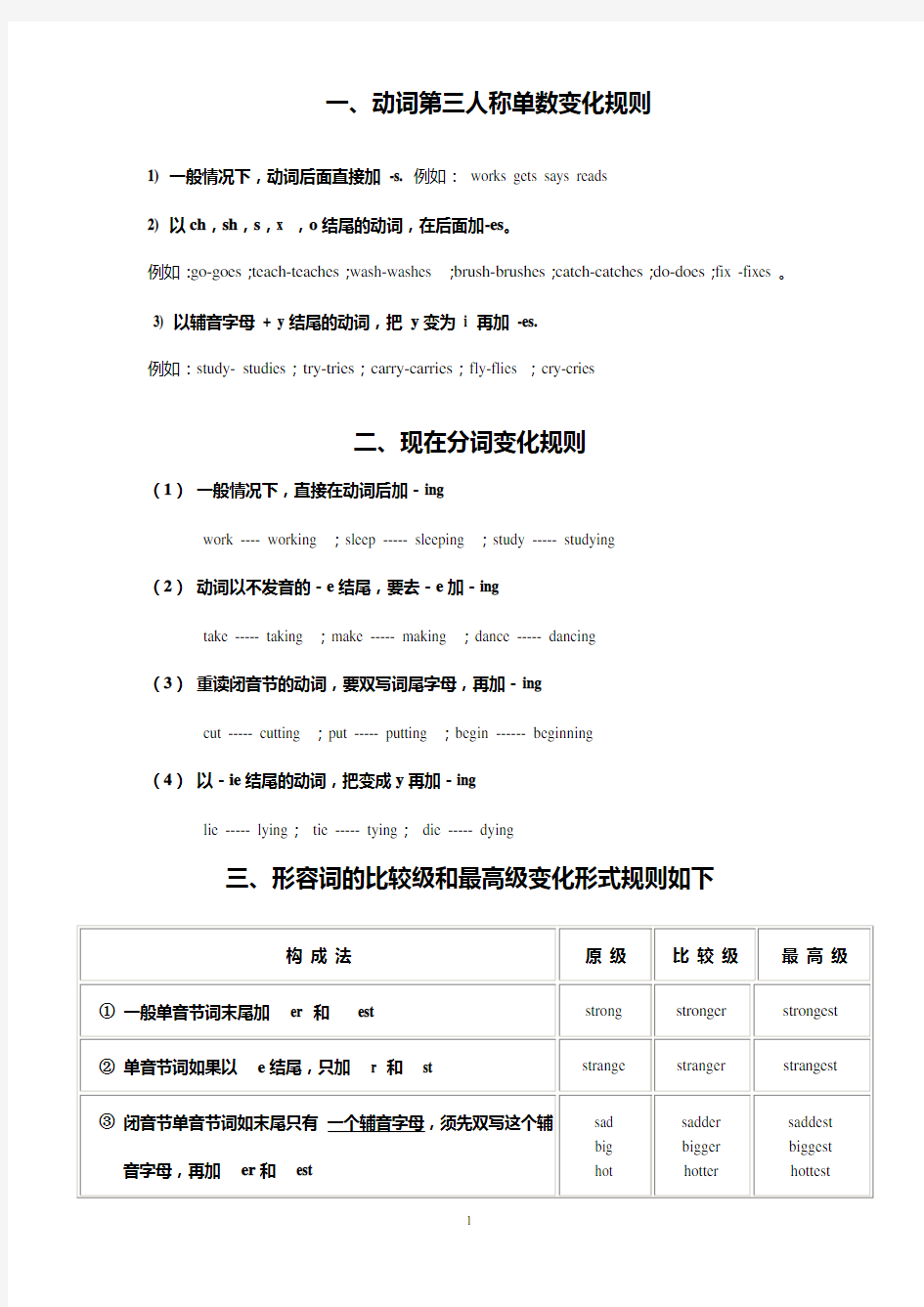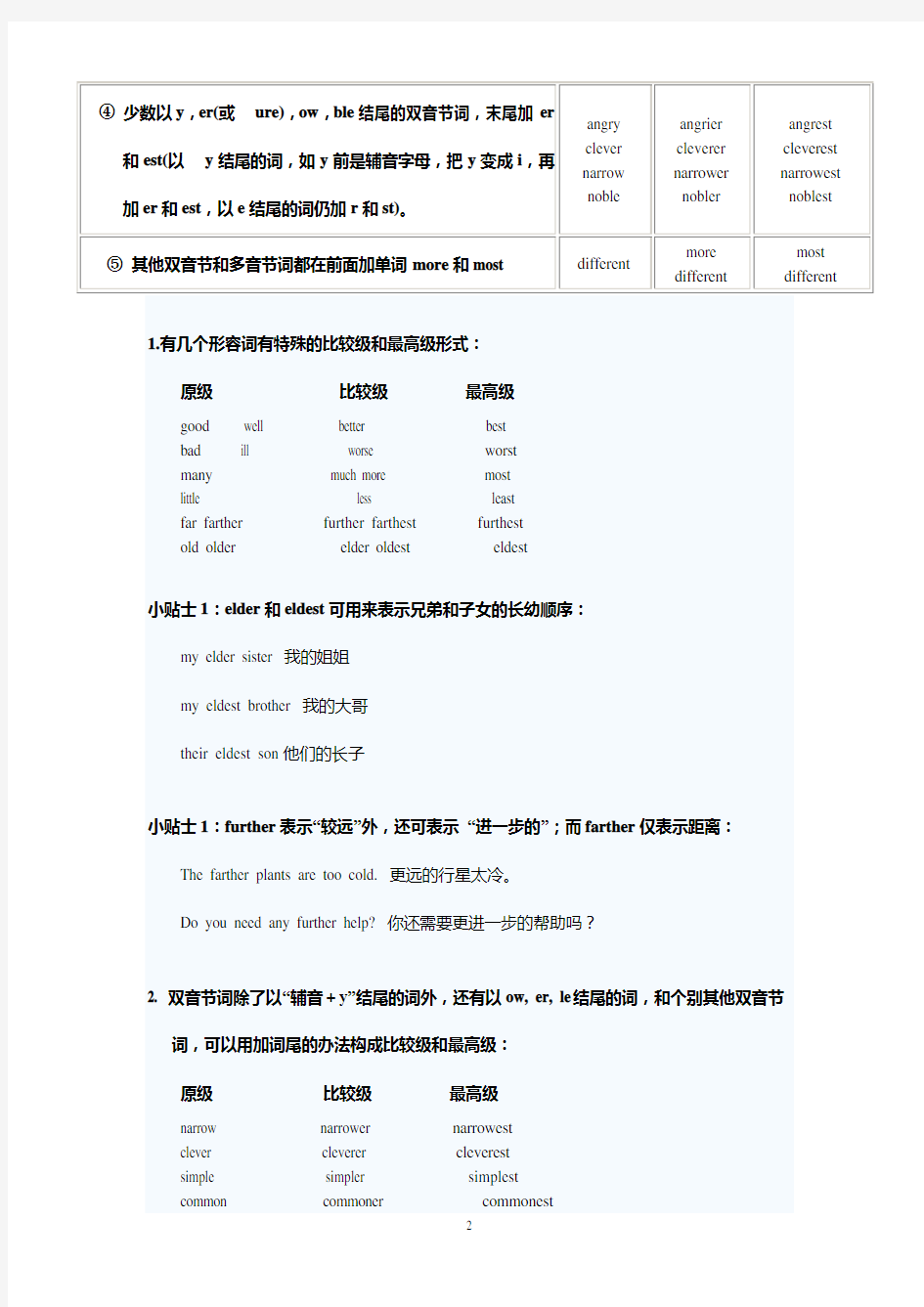(完整版)动词各种词性变化规则


一、动词第三人称单数变化规则
1) 一般情况下,动词后面直接加-s. 例如:works gets says reads
2) 以ch,sh,s,x ,o结尾的动词,在后面加-es。
例如:go-goes;teach-teaches;wash-washes ;brush-brushes;catch-catches;do-does;fix -fixes 。
3) 以辅音字母+ y结尾的动词,把y变为i 再加-es.
例如:study- studies;try-tries;carry-carries;fly-flies ;cry-cries
二、现在分词变化规则
(1)一般情况下,直接在动词后加-ing
work ---- working ;sleep ----- sleeping ;study ----- studying
(2)动词以不发音的-e结尾,要去-e加-ing
take ----- taking ;make ----- making ;dance ----- dancing
(3)重读闭音节的动词,要双写词尾字母,再加-ing
cut ----- cutting ;put ----- putting ;begin ------ beginning
(4)以-ie结尾的动词,把变成y再加-ing
lie ----- lying;tie ----- tying;die ----- dying
三、形容词的比较级和最高级变化形式规则如下
①一般单音节词末尾加er 和est
②单音节词如果以e结尾,只加r 和st
③闭音节单音节词如末尾只有一个辅音字母,须先双写这个辅
音字母,再加er和est
④少数以y,er(或ure),ow,ble结尾的双音节词,末尾加er
和est(以y结尾的词,如y前是辅音字母,把y变成i,再加er和est,以e结尾的词仍加r和st)。
3. 也有少数单音节词可以加more和most的办法构成比较级和最高级:
原级比较级最高级
pleased more pleased most pleased
tired more tired most tired
glad more glad most glad
四、名词的复数形式
名词复数的不规则变化
1)child---children;foot---feet ;tooth---teeth ;mouse---mice;man---men woman---women
注意:与man 和woman构成的合成词,其复数形式也是-men 和-women。
如:an Englishman,two Englishmen. 但German不是合成词,故复数形式为Germans;
Bowman是姓,其复数是the Bowmans。
2)单复同形如:deer,sheep,fish,Chinese,Japanese
但除人民币元、角、分外,美元、英镑、法郎等都有复数形式。
如: a dollar, two dollars; a meter, two meters
3)集体名词,以单数形式出现,但实为复数。
如people;police ;cattle 等本身就是复数,不能说a people,a police,a cattle,但可以说a person,a policeman,a head of cattle, the English,the British,the French,the Chinese,the Japanese,the Swiss 等名词,表示国民总称时,作复数用。
如:The Chinese are industries and brave. 中国人民是勤劳勇敢的。
4)以s结尾,仍为单数的名词,如:
a. maths,politics,physics等学科名词,为不可数名词,是单数。
b. news 是不可数名词。
c. the United States,the United Nations 应视为单数。
The United Nations was organized in 1945. 联合国是1945年组建起来的。
d. 以复数形式出现的书名,剧名,报纸,杂志名,也可视为单数。
"The Arabian Nights" is a very interesting story-book.
<<一千零一夜>>是一本非常有趣的故事书。
5) 表示由两部分构成的东西,如:glasses (眼镜) trousers, clothes
若表达具体数目,要借助数量词pair(对,双); suit(套); a pair of glasses; two pairs of trousers 6)另外还有一些名词,其复数形式有时可表示特别意思,如:goods货物,waters水域,fishes(各种)鱼
词性转换常见规律归纳
动词变名词1.v+ ment 结尾 achieve---achievement 成就advertise---advertisement advertising agree— agreement argue---argument争吵announce --- announcement 通知amuse--- amusement 娱乐commit奉献—commitment develop---development disgree—disagreement equip装备---equipment装备,器材govern 统治—government 政府manage---management 经营管理settle--- settlement 定居 2.V+ tion 结尾以t, te, de, 结尾的动词常去E 或直接加ion admit 承认—admission attract吸引—attraction 有吸引力的事或人;令人向往的地方 conclude—conclusion 结论compete—competition竞争,比赛discuss—discussion 讨论educate-----education decide----decision describe—description描写,描绘organize----organization imagine—imagination 想象力introduce—introduction 介绍instruct—instruction 指导,介绍invent—inventor / invention illustrate 阐明,举例说明--illustration invite—invitation inspire---inspiration 灵感,鼓舞人心的pollute----pollution 污染 predict---prediction 预言pronounce ---pronunciation resolve 决心-----resolution 决心impress 给人印象—impression 印象 permit 允许-----permission suggest-建议,暗示--suggestion solve解决-----solution 解决方法 3.V+ ance 结尾 allow—allowance 允许appear—appearance 外貌,出现perform----performance 演出exist—existance 存在 4.V+ ing 结尾 bathe 洗澡---bathing end 结束----ending 结尾,结局train 训练---training mean ---- meaning 意义say-----saying 谚语 5.V+ 其他 beg(乞讨)—beggar 乞丐 sit--seat 座位
高中英语常用词形变化规则精编
高中英语常用词形变化规则精编 一、动词 1. 动词过去式和过去分词 1). 一般在动词原形后加-ed look --- looked; need--- needed 2). 以-e结尾的动词加-d move --- moved 3). 以辅音字母加y结尾的动词,变y为i,再加-ed carry --- carried; study--- studied;以元音字母加y结尾的词,直接加-ed stay--- stayed; destroy---destroyed 4).以重读闭音节结尾的单词,双写最后的辅音字母,再加-ed. stop--- stopped; regret --- regretted 知识链接:重读闭音节三要素 (1)一个元音字母后跟一个或几个辅音字母,必须是重读音节; (例如prohibit这个词,重读音节在-hi,而不在-bit,就不要双写t. prohibit---prohibited) (2)以一个辅音音素结尾;(例如fix,结尾的辅音音素为两个:/ks/,就不要双写x, fix---fixed; snow结尾为双元音/??/,也不要双写w. (3)元音字母发短元音。[?] [e] [i] [?] [?] 5). 以-r音节(重读)结尾的词,双写r字母,再加-ed. refer ---referred; prefer --- preferred ; 如果-r音节不重读,则不用双写:offer---offered 6). 以-l结尾的动词,如果是重读闭音节,双写l, 再加-ed, 例如:control---controlled; 如果不重读,双写不双写l均可,例如travel---travelled/ traveled; quarrel---quarrelled / quarreled 2. 动词-ing变化规则 1). 一般情况下,直接在动词后加-ing work --- working; sleep --- sleeping; study--- studying 2). 动词以不发音的-e结尾,要去-e加-ing take --- taking; make ---making; dance --- dancing 3). 重读闭音节的动词,要双写词尾字母,再加-ing cut--- cutting;put ---- putting; begin ---- beginning 4). 以-ie结尾的动词,把变成y再加-ing lie ---- lying ; tie ---- tying; die ---- dying 5). 以-l结尾的动词,如果是重读闭音节,双写l, 再加-ing, 例如:control---controlling; 如果不重读,双写不双写l均可,例如travel---travelling/ traveling; quarrel---quarrelling / quarreling (注意:辅音之后y变i, 现在分词是例外。) 3. 动词第三人称单数的变化规则: 1) 一般情况下,词尾加s,如;like----likes, want----wants. 2) 以s, x, ch, sh, o结尾的加es,如,watch---watches, go---goes 3) 以y结尾的归两大类:元音字母+y要加s,如play----plays ;辅音字母+y要变y为i+es如study---studies 二、名词 1. 规则的可数名词的复数变化: 1).一般情况加s :book-- books mouth---mouths house---houses girl---girls 2).以s 、sh 、ch 、x结尾的加es :class--- classes box----boxes match----matches 注意: (1) 以-th结尾的名词直接加-s如:mouth—mouths path—paths ; month—months, ninth—ninths, youth—youths. (2) stomach---stomachs (ch发/k/) 1
词性转换规律
一.形容词变副词规律小结
二.名词复数的变化规律 1、规则变化 1) 一般情况直接在词尾加-s . 如:chair—chairs;apple—apples;grape—grapes; 2)以s、sh、ch、x等结尾的词加–es .如:bus—buses;watch—watches;box—boxes;brush —brushes 3)以辅音字母+y结尾的词,变y 为i 再加es,baby—babies;city—cities;family—families 4)以f或fe结尾的将f或fe直接换成ves. 如:knife—knives;thief—thieves;shelf—shelves 2、不规则变化 1)没有规律的变化。如:child—children;foot—feet;tooth—teeth;mouse—mice; woman—women等。 2)单复同形。如:deer—deer;sheep—sheep;fish—fish;yuan—yuan;tofu—tofu; pork—pork等。 3)以o结尾的名词有的加es有的加s. 如:potato—potatoes;tomato—tomatoes;Hero—heroes 二、动词第三人称单数的变化规则 1)直接在动词后+s. 如:like—likes;play—plays;read—reads;get—gets;help—helps; ski—skis等。 2)以s, x, sh, ch, 接尾的动词:+es. 如:wash—washes;wacth—watches;teach—teaches; brush—brushes等。 3)以辅音+o接尾的动词:+es. 如:go—goes;do—does等。 4)以辅音+y接尾的动词:变y为i+es. 如:fly—flies;study —studies;carry—carries; sky—skies等。 末尾字母y前为元音字母的,直接在动词后面加-s. 如:play—plays;say—says 5)特殊变化。如:be—is;have—has等。这些没有规律,需要加强记忆。 三、动词现在分词-ing形式的构成 1)一般情况在动词原形后加-ing . 如:go—going;stand—standing;climb—climbing等。2)以不发音的e结尾的动词,去掉e,再加-ing. 如:write—writing;hope—hoping;care—caring 3)以-ie结尾的动词应先将e去掉,将i变成y然后再加-ing. 如:die—dying,tie—tying等。4)如果动词最后一音节为重读闭音节,最后一个字母需要重复. 如:run—running; stop—stopping;hop—hopping;plan—planning;star—starring;但辅音x是个例外,无需重复(x其实起着两个辅音的作用)。如:tax—taxing,relax—relaxing等。 5)以-ee,-oe,-ye结尾的动词加-ing时应保留词尾e. 如:see—seeing;hoe—hoeing;eye—eyeing 6)-ic结尾的动词应先在字母c后加一字母k再加-ing. 如:panic—panicking; picnic—picnicking 三.动词变名词小结 1.在词尾加er,r ,双写加er 或or: A. play _ player, sing _ singer, wait _ waiter , find _ finder, thrill _ thriller
高考词汇词性变化规律:动词类变化
高考词汇词性变化规律:动词类变化 词性变化之动词类1. 动词+后缀-y 变为名词deliver → delivery 运送discover → discovery 发现recover → recovery 康复;恢复 2. 动词+后缀-ing 变为名词 begin → beginning 开始;开端 build → building 建筑(物) cross → crossing 十字路口end → ending 结局;结尾engine → engineering 工程feel → feeling 感觉 hear → hearing 听力market → marketing 促销meet → meeting 会议paint → painting 绘画;油画spend → spending 花销suffer → suffering 苦难 train → training 训练;培养 3.动词+后缀-ment 变为名词
acquire → acquirement n. 取得accomplish → accomplishment 成就achieve → achievement 成就adjust → adjustment 调整;调节amuse → amusement 愉快;快乐;消遣announce → announcement 宣告;述说appoint → appointment 约会;预约;任命 argue → argument 争论arrange → arrangement 安排 assess → assessment 评估assign → assignment 分配;任务 astonish → astonishment 惊讶 develop → development 发展disappoint → disappointment 失望embarrass → embarrassment 尴尬 employ → employment 雇用enjoy → enjoyment 享受;欢乐entertain → entertainment 款待;娱乐equip → equipment 设备 establish → establishment 建立
动词ing和三单形式的变化规则
1.一般情况下直接加ing play玩—playing listen听---listening read stories(读故事书)-- reading stories climb mountains(爬山)-- climbing mountains 2.以不发音的e结尾的动词,去e,再加ing make制做—making dance跳舞---dancing come来---coming 3.辅音+元音+辅音结尾的单词,双写词尾字母再加ing *(元音字母a、e、i、o、u)swim游泳—swimming run跑步—running stop停止—stopping shop购物—shopping 当主语是第三人称单数时,谓语动词要用第三人称单数形式, 如:I play football. He plays football. I live in Shanghai. Sarah lives in Shanghai. 主语第三人称单数形式:he / she / it / my father… /Amy / Zhang Peng… 1.一般情况在词尾加s: like—likes dance---dances live居住—lives 2.以o、s、x 、sh、ch结尾的单词加es. do—does go-- goes teach教--- teaches watch看--watches wash clothes洗衣服--- washes clothes 3.以元音(aeiou)+y结尾的单词,加s: play-- plays say说-- says 4.以辅音+y结尾的单词,变y为i再加es :fly kites放风筝-- flies kites study学习-- studies 5.特殊记:have有—has I have a book. She has a book. 1.一般情况下直接加ing play玩—playing listen听---listening read stories(读故事书)-- reading stories climb mountains(爬山)-- climbing mountains 2.以不发音的e结尾的动词,去e,再加ing make制做—making dance跳舞---dancing come来---coming 3.辅音+元音+辅音结尾的单词,双写词尾字母再加ing *(元音字母a、e、i、o、u)swim游泳—swimming run跑步—running stop停止—stopping shop购物—shopping 当主语是第三人称单数时,谓语动词要用第三人称单数形式, 如:I play football. He plays football. I live in Shanghai. Sarah lives in Shanghai. 主语第三人称单数形式:he / she / it / my father… /Amy / Zhang Peng… 1.一般情况在词尾加s: like—likes dance---dances live居住—lives 2.以o、s、x 、sh、ch结尾的单词加es. do—does go-- goes teach教--- teaches watch看--watches wash clothes洗衣服--- washes clothes 3.以元音(aeiou)+y结尾的单词,加s: play-- plays say说-- says 4.以辅音+y结尾的单词,变y为i再加es :fly kites放风筝-- flies kites study学习-- studies 5.特殊记:have有—has I have a book. She has a book.
英语单词词性转换的基本规律
英语单词词性转换的基本规律 (1.动词(v.)→名词(n.) (a)词形不变,词性改变 例如:work, study, water, plant等可以用作动词(工作,学习,浇水,种植),也可以用作名词(工作,学习,水,植物). (b)一些动词在词尾加上-er或-or之后就变成了表示"某一类人"的名词 例如:work—worker, teach—teacher, sing—singer, jump—jumper, play—player, learn—learner, visit—visitor, invent—inventor, collect—collector等. 注意:1)以不发音的e结尾的动词,在词尾加-r. 例如:drive—driver, write—writer等. 2)以重读闭音节结尾,且末尾只有一个辅音字母的动词,应双写末尾的辅音字母,再加-er 例如:run—runner, win—winner, begin—beginner等. (c)在动词词尾加上-ment 变成名词 例如:achieve—achievement (成就) advertise—advertisement//advertising(广告) agree—agreement disgree—disagreement amuse—amusement (娱乐) improve—improvement(争吵) commit(奉献)—commitment develop—development (发展) depart—department (局,部) govern(统治)—government(政府) manage—management (管理) equip—equipment (装备) 有些单词比较特殊,需把动词后的e去掉再加ment. 例如:argue—argument(争论)
(完整版)动词各种词性变化规则
一、动词第三人称单数变化规则 1) 一般情况下,动词后面直接加-s. 例如:works gets says reads 2) 以ch,sh,s,x ,o结尾的动词,在后面加-es。 例如:go-goes;teach-teaches;wash-washes ;brush-brushes;catch-catches;do-does;fix -fixes 。 3) 以辅音字母+ y结尾的动词,把y变为i 再加-es. 例如:study- studies;try-tries;carry-carries;fly-flies ;cry-cries 二、现在分词变化规则 (1)一般情况下,直接在动词后加-ing work ---- working ;sleep ----- sleeping ;study ----- studying (2)动词以不发音的-e结尾,要去-e加-ing take ----- taking ;make ----- making ;dance ----- dancing (3)重读闭音节的动词,要双写词尾字母,再加-ing cut ----- cutting ;put ----- putting ;begin ------ beginning (4)以-ie结尾的动词,把变成y再加-ing lie ----- lying;tie ----- tying;die ----- dying 三、形容词的比较级和最高级变化形式规则如下 ①一般单音节词末尾加er 和est ②单音节词如果以e结尾,只加r 和st ③闭音节单音节词如末尾只有一个辅音字母,须先双写这个辅 音字母,再加er和est
动词ing形式的用法及变化规则
动词ing形式的用法及变化规则 一.动词ing形式的用法 1.正在进行时中,谓语动词后加ing. 如:I'm playing football. 2.一些特殊表达..如: be good at doing sth enjoy doing sth. be busy doing feel like doing thank you for doing do some cooking/cleaning/reading/shopping/washing go swimming/fishing/shopping/skating/boating 二.动词现在分词由动词原形在词尾加ing构成,其规则如下: 1)一般情况下直接加ing think---thinking sleep---sleeping study---studying speak---speaking carry---carrying say---saying 2)以不发音的字母e结尾的单词,去掉字母e,再加ing wake---waking make---making come---coming take---taking leave---leaving have---having 3)以重读闭音节结尾,呈现“辅,元,辅”结构的动词,先双写末尾的辅音字母,再加ing 。初中学过的这类词有:begin,cut, get, hit, run, set, sit, spit, stop, swim, beg, drop, fit, nod, dig, forget, regret, rid, 等。 (visit 不是以重读闭音节结尾,不用双写) travel虽然重读第一音节,词尾音节不重读,但是现在分词仍要双写末尾辅音字母,然后再加ing ,如:travel---travelling.初中阶段此类词只有这一个。4)以 y 结尾的动词直接加 ing carry—— carrying enjoy—— enjoying 5)以ie结尾的动词,把ie改为y ,再加ing
动词过去式变化规则大全汇编
一、规则动词(Regullar Verbs) 的过去式由“动词原形+-ed”构成,具体变化有: 1. 一般的直接在词尾加-ed。如: want—wanted, work—worked, need—needed, clean—cleaned 2. 以不发音的e结尾的在词尾加-d。如:like—liked, live—lived, use—used, move—moved smile--smiled; hope--hoped. 注意:ie结尾动词,直接加d: died;tied. 3. 以一个元音字母加一个辅音字母结尾的重读闭音节动词,先双写结尾的辅音字母,再加-ed。如:stop—stopped, trip—tripped planned; 4. 以辅音字母加y结尾的动词,先把y变成i,再加-ed。如:study—studied, carry—carried, hurry—hurried, marry—married worried; studied. 注意:规则动词过去式加“ed”后的发音规则: 在浊辅音和元音后面[d] called [k?:ld] borrowed[b?r??d] moved[mu:vd] 在清辅音后面[t] helped[helpt] passed[pa:st] 在[t] [d]音后面[id] started['sta:tid] counted['kauntid] needed['ni:did] counted['kauntid]补充说明: 二、不规则动词(Irregular Verbs)的过去式大体上归纳有以下记忆法: 1. 以t结尾的词,过去式与原形相同。如:put—put, let—let, cut—cut, beat—beat read—read must--must 2. 以d结尾的词,把d变成t。如:build—built, lend—lent, send—sent, spend—spent 3. 以n结尾的词,在词后加t。如:mean—meant, burn—burnt, learn—learnt 4. 以ow / aw结尾的词,把ow / aw变成ew。如:blow—blew, draw—drew, know—knew, grow—grew throw—threw(动词show除外,show—showed) 5. 含有双写字母的词,将双写改为单写,在词尾加t。如:keep—kept, sleep—slept, feel—felt, smell—smelt sweep—swept 6. 含有元音字母o / i的词,将o / i变成a。如:come—came become—became sing—sang, give—gave, sit—sat, drink—drank 7.以ought和aught结尾,且读音是〔:t〕的过去式。如: bring—brought,buy— bought,think—thought,catch—caught,teach—taught 8.把重读开音节中的i改为o,变成过去式。如: drive—drove,ride—rode,write—wrote 9.动词原形中的e改为o,如: get—got,forget—forgot
英语单词词性转变的一般规律
英语单词词性转变的一般规律 1.动词(v.)→名词(n.) (a)词形不变,词性改变 例如:work, study, water, plant等可以用作动词(工作,学习,浇水,种植),也可以用作名词(工作,学习,水,植物). (b)一些动词在词尾加上-er或-or之后就变成了表示"某一类人"的名词 例如:work—worker, teach—teacher, sing—singer, jump—jumper, play—player, learn—learner, visit—visitor, invent—inventor, collect—collector等. 注意:1)以不发音的e结尾的动词,在词尾加-r. 例如:drive—driver, write—writer等. 2)以重读闭音节结尾,且末尾只有一个辅音字母的动词,应双写末尾的辅音字母,再加-er 例如:run—runner, win—winner, begin—beginner等. (c)在动词词尾加上-ment 变成名词 例如:achieve—achievement (成就) advertise—advertisement//advertising(广告) agree—agreement disagree—disagreement amuse—amusement (娱乐) improve—improvement(争吵) commit(奉献)—commitment develop—development (发展) depart离开;出发,起程;违反;去世—department (局,部) govern(统治)—government(政府) manage—management (管理) equip—equipment (装备) 有些单词比较特殊,需把动词后的e去掉再加ment. 例如:argue—argument(争论) (d)在动词词尾加上-(t)ion/(s)ion变成名词 例如: attract—attraction; instruct—instruction; invent—invention discuss—discussion; express—expression educate—education; graduate—graduation; operate—operation (去e再加"ion") compete—competition; organize—organization (把e改成其他字母再加"tion") decide—decision conclude—conclusion (把de改为s再加"ion") describe—description描写,描绘 (这是特例,不规则变化) (e)在动词词尾加上-ance变成名词 例如: appear—appearance (外貌;出现) perform—performance (演出) accept—acceptance (接受) (f)在动词词尾加-ing变成名词 (方法与动词变为现在分词的方法相同) 例如:meet—meeting build—building wait—waiting bathe—bathing say—saying(谚语) mean—meaning
常用词性转换
adj——n brave-bravery wise-wisdom necessary-necessity safe-safety real-reality major-majority consider- considerate true-truth honest-honesty social-society young-youth free-freedom anxious-anxiety curious-curiosity various-variety poisonous-poison weigh-weight high-height strong-strength long-length wide-width deep-depth true-truth safe-safety pride-proud possible-possibility-possibly responsible-responsibility n ——adj/adv absence-absent importance-important convenience-convenient distant-distance confidence-confident significance-significant elegance-elegant intelligence-intelligent violence-violent silence-silent difference-different patience-patient thirst-thirsty dirt-dirty taste-tasty day-daily year-yearly week-weekly east-eastern love-lovely live-lively friend-friendly nerve-nervous face-facial fog-foggy sun-sunny nature-natural nation-national music-musician- musical benefit-beneficial hunger-hungry-hungrily fortune-fortunate-fortunately anger-angry-angrily noise-noisy-noisily wisdom-wise eight-eighth-eighty-eightieth nine-ninth twelve- twelfth n/v ——adj/adv hurry-hurriedly expect-(un)expectedly increase-increasingly surprise-surprisingly amaze-amazingly lucky-luckily comfort-uncomfortable forget-forgettable simple-simply v ——n arrive-arrival survive-survival approve-approval occupy-occupation decide-decision explain-explanation permit-permission admit-admission describe-description determine-determination discuss-discussion recognize-recognition consume-consumption assume-assumption conclude-conclusion believe-belief(s) relieve-relief
词性转换
8B期中复习词性转换2016.4 1.When insects attack a tree, it can __ a chemical to protect itself. (product) 2.It’s difficult to look ___ before others when you are feeling nervious. (nature) 3.People in big cities have to fight against different kinds of ___. (pollute) 4.Nowadays, farmers are moving away from the use of ___ on vegetables. (chemistry) 5.Be careful! It’s __ to walk on thin ice in a lake. (danger) 6.These children want to be ___ when they grow up. (science) 7.Drinking too much pure water is also ___ to our health. (harm) 8.He ___ sipped his wine, enjoying the wonderful music. (slow) 9.With the doctor’s hard work, the old lady is out of ___ now. (dangerious) 10.T he store are open __ except on Sundays. (day) 11.W e ordered some new dishes today. It was a ___ of the waiter. (suggest) 12.H ary looked ___ that Jim didn’t seem to remember him. (puzzle) 13.W hen we were out of danger, we started to ___. (relaxing) 14.A fter long work, my Dad enjoyed resting ___ in a sofa. (comfortable) 15.G race gave the room a throught ___ this morning. (clean)
词性转换
词性转换 训练导语 1.动词转换成名词的一些规则。 (1)动词+er: sing→singer teach→teacher clean→cleaner speak→speaker play→player wait→waiter work→worker think→thinker draw→drawer follow→follower perform→performer own→owner discover→discoverer fight→fighter 但须注意,有些动词转换成名词时,需要重复其词尾的辅音字母,然后再加er,如win→winner;run→runner;begin→beginner。如以e结尾的动词变为名词时,直接加r,如drive→driver; dance→dancer; write→writer; love→lover; use→user; lose→loser; computer→computer; manage→manager. (2)动词+ing: cook→cooking sing→singing paint→painting build→building read→reading spell→spelling mean→meaning draw→drawing understand→understanding 但须注意,有些以e结尾的动词变为名词时,先去e再加ing,如write→writing;live→living. (3)动词+ion: Invent→invention discuss→discussion 但须注意,有些以e结尾的动词变为名词时,先去e再加ion,如operate→operation;pollute→pollution。 (4)同时的动词和名词: water(浇水)→water(水)cover(覆盖)→cover(封面,盖子) change(变成)→change(变化,零线) 2.形容词转换成副词的一些规则。 (1)形容词+ly: slow→slowly quick→quickly (2)变y为i+ly: busy→busily happy→happily easy→easily
动词形式的用法及变化规则
动词i n g形式的用法及变化规则一.口诀:nowlooklistenbe,动词要加ing,加了ing,不要忘了be。? 二.动词现在分词由动词原形在词尾加ing构成,其规则如下:? 1)一般情况下直接加ing????think---thinking?????sleep---sleeping? ???????????????????????????study---studying???speak---speaking? ???????????????????????????carry---carrying?????say---saying 2)以不发音的字母e结尾的单词,去掉字母e,再加ing wake---waking????make---making????come---coming? take---taking??????leave---leaving????have---having? 3)以重读闭音节结尾,呈现“辅音,元音(aeiou),辅音”结构的动词,先双写末尾的辅音字母,再加ing?。 这类词有:shop,begin, cut,put,get,hit,run,set,sit,spit,stop,swim,beg,drop,fit,nod,dig,forget,regret,rid,?等。? (visit?不是以重读闭音节结尾,不用双写) travel虽然重读第一音节,词尾音节不重读,但是现在分词仍要双写末尾辅音字母,然后再加ing?,如:travel---travelling.初中阶段此类词只有这一个。 4)以ie结尾的动词,把ie改为y?,再加ing 如:die---dying?????lie---lying? 一. 写出下列动词的现在分词形式 二. work___________?visit__________??play__________?study________dance_______have __________??travel_________take__________ drop__________?sing__________?shop________swim_________lie__________
动词的各种时态及变化规则
动词的各种时态及变化规则 一、一般现在时 用法:1.现阶段经常性、习惯性动作; 2.目前的状态; 3.客观真理。 构成:主语是第三人称单数时,作谓语的行为动词要在词尾加-s(-es),其他人称和数用动词原形。 否定形式:am/is/are+ not;此时态的谓语动词若为行为动词,则在其前加don't,如主语为第三人称单数,则用doesn't,同时还原行为动词。 一般疑问句:把be动词放于句首;用助动词do提问,如主语为第三人称单数,则用does,同时,还原行为动词。 时间状语:always, usually, often, sometimes, every week (day, year, month…), once a week, on Sundays 动词的变化规则 (1)一般直接在词尾+s runs likes (2) 以s, sh, ch, x, o结尾的动词在词尾+es goes passes (3) 以辅音字母+y结尾的动词,要把y变i+es study ---studies try----tries (4) 以元音字母+y结尾的动词,直接在后+s stays plays 二、现在进行时 用法:a. 表示现在( 指说话人说话时) 正在发生的事情。 b. 表示长期的或重复性的动作,说话时动作未必正在进行。 构成:主语+am / is / are + 动词的现在分词(即动词-ing 形式) 否定形式:主语+am / is / are + 动词的现在分词 一般疑问句:把am / is / are放于句首。 时间状语:these days, now, at the moment, look, listen. 现在分词的变化规则 (1).一般直接在动词词尾+ing reading (2).以不发音e结尾的动词要把e去掉+ing live---living (3).以重读闭音节的结尾且末尾只有一个辅音字母的动词,双写辅音字母再ing run---running 注:重读闭音节:辅+元+辅并且元音是单元音(4).特殊记忆的动词die---dying 死lie---lying 躺tie---tying 栓系 三、一般过去时 用法:过去某个时间里发生的动作或状态;过去习惯性、经常性的动作、行为。
英语词性转换规则大全
英语词性转换规则大全 (1).动词转化为名词, post-postage mail-mail weigh-weight advise-advice (2)动词转化成名词-形容词 act-actor / actress-active change-change-changeable (3) 动词转化成形容词,副词,名词 fill-full need-necessary-necessarily interest(v. / n.) interested /interesting (4)n. a. n. a.名词转化为形容词 person personal ( 个人的; 私人的 ) fun funny (5)n. pl. n. pl.名词转化为名词复数 gentleman gentlemen human humans (6)a. ad. a. ad.形容词转化为副词 possible possibly probable probably (7)a. ad. n.形容词转化为副词,名词 true truly truth lucky luckily luck (8)原级比较级最高级 far farther / further farthest / furthest little less least 一、名词变为形容词的方法 1. 在名词后面加-y可以变成形容词(尤其是一些与天气有关的名词)。例如:rain—rainy, cloud—cloudy, wind—windy, snow—snowy, health—healthy, luck—lucky等。 注意:1)如果名词以重读闭音节结尾,且词尾只有一个辅音字母,这时应双写词尾的辅音字母再加-y。如:sun—sunny, fun—funny等。 2)少数以不发音的e结尾的名词变为形容词时,应去掉e再加-y。例如:noise—noisy, ice—icy 等。
